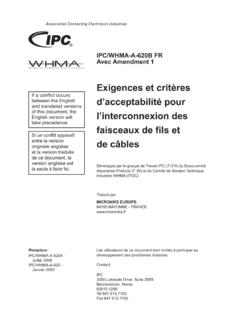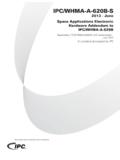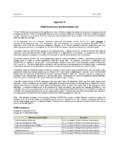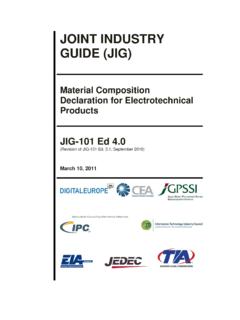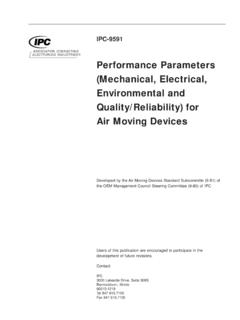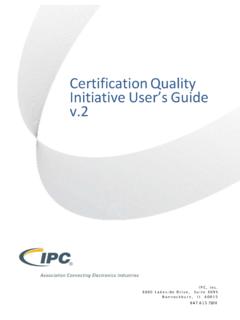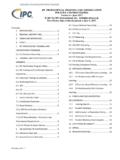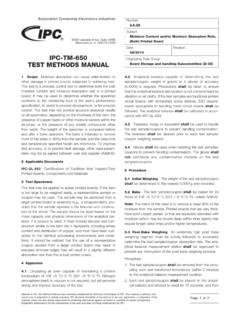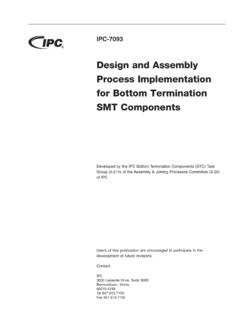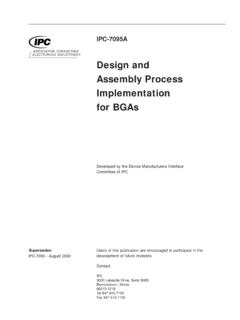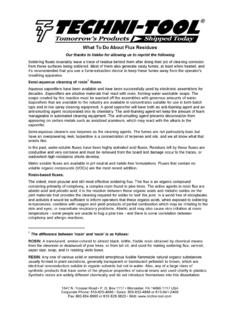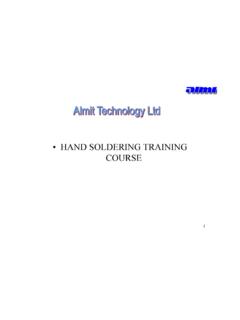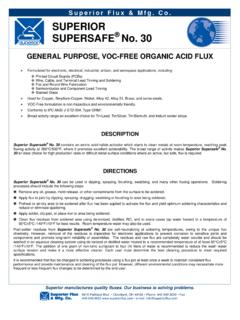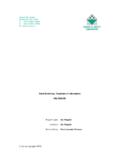Transcription of IPC-TM-650 TEST METHODS MANUAL
1 1 ScopeThis test method is to characterize fluxes bydetermining the degradation of electrical insulation resistanceof rigid printed wiring board specimens after exposure to thespecified flux . This test is carried out at high humidity and Applicable DocumentsIPC-B-24 Surface Insulation Resistance Test BoardIPC-A-600 Acceptability of Printed BoardsIPC J-STD-004 Requirements for Soldering FluxesIPC-9201 Surface Insulation Resistance Handbook3 Test SpecimenA minimum of 10 ml of liquid flux , a rep-resentative container of solder paste, cored wire, paste flux , orextracted solder preform flux . The reflow/extraction processshould be carried out in accordance with IPC Comb PatternsUse the IPC-B-24 test pattern (seeFigure 1), which consists of four comb patterns per individual comb has mm lines and mm metallization shall be unpreserved bare LaminatThe laminate material for this test shall beFR-4 clean test chamber capable of programming andrecording an environment of 25 +10/-2 C [77 + 18/-3 F] toat least 85 2 C [185 F] and 20% 5% to 85% 2%relative humidity.
2 A salt solution and desiccator may be usedto maintain humidity if a tight temperature control is main-tained on the power supply capable of producing a standing biaspotential of 45-50 volts DC with a tolerance of 10%. resistance meter capable of reading high resistance(1012ohms) with a test voltage of 100 volts, or an ammetercapable of reading 10-10amps in combination with 100 voltsDC power 2000 ml ventilation bristle or distilled water (2 megohm-cm minimumresistivity recommended). oven capable of maintaining at least 50 C[122 F].5 Test ConditionsAll fluxes will be tested at 85 2 C,[185 F], 85 2% relative humidity for 168 Specimen PreparationThere shall be three test cou-pons for each liquid flux to be tested in the cleaned state(Table 1, Sample Group A). When testing liquid fluxes whichare intended to remain in the uncleaned state, six test cou-pons are required.
3 Three uncleaned test coupons shall besoldered pattern side down (Table 1, Sample Group B) andthree shall be soldered pattern side up (Table 1, SampleGroup C).Solder paste coupons shall be reflowed pattern side up andeither cleaned (Table 1, Sample Group D) or not cleaned(Table 1, Sample Group E).IPC-2633-1 Figure 1 Test Pattern from IPC-B-242215 Sanders RoadNorthbrook, IL 60062-6135 IPC-TM-650 TEST METHODS Insulation Resistance, FluxesDate06/04 RevisionBOriginating Task GroupFlux Specifications Task Group, (5-24a)Material in this Test METHODS MANUAL was voluntarily established by Technical Committees of IPC. This material is advisory onlyand its use or adaptation is entirely voluntary. IPC disclaims all liability of any kind as to the use, application, or adaptation of thismaterial. Users are also wholly responsible for protecting themselves against all claims or liabilities for patent referenced is for the convenience of the user and does not imply endorsement by CONNECTINGELECTRONICS INDUSTRIES In addition, there shall be at least two unprocessed controlcoupons for comparison purposes (Table 1, Sample Group F).
4 , permanent and noncontaminating identifica-tion of test specimens is of paramount importance. (Forexample, a vibrating scribe.) Permanent ink may be used onthe back side of the test coupon if areas beneath conductorsare inspect the test specimens for any obviousdefects, as described in IPC-A-600. If there is any doubtabout the overall quality of any test specimen, the test speci-men should be each test or control coupon with deionized ordistilled water and scrub with a soft bristle brush for a mini-mum of 30 seconds. Spray rinse thoroughly with deionized ordistilled water. Rinse the cleaned area thoroughly with alternative cleaning method is to place the test coupon inan ionic contamination tester containing 75% 2-propanol,25% deionized water and process the solution until all ionicshave been the remainder of the specimen preparation, handle testspecimens by the edges only, and use noncontaminating rub-ber the cleaned boards for two hours at 50 C[122 F].
5 Boards are to be stored before treatment, place theboards in Kapak bags or other contamination-free contain-ers (do not heat seal) in a Sample PreparationFlux application and Liquid flux or flux ExtractCoat the test patternwith a thin coating of the liquid flux or flux extract under the flux coated test coupon using the tem-perature profile recommended by the vendor. If no profile isavailable, preheat the test coupon in an oven set at a tem-perature such that the test coupon reaches a temperature of140 C [284 F] in 30 to 45 expose the test coupon to solder byfloating the fluxed comb patterns of the test specimen facedown on the solder pot at 245-260 C [473-500 F] for4 1seconds. Be sure that all dross is removed from the solder potsurface just before contact with the , the specimen can be wave solderedface down at 245-260 C [473-500 F] and a conveyor speedwith a contact time of3 fluxes to be tested in the uncleaned state, asecond set of test patterns shall be fluxed and floated patternup on the solder pot or passed pattern up over the Solder Paste or Paste FluxStencil print the solderpaste or paste flux onto the comb pattern using a mm[ in] (6 mil) thick stencil (the IPC-A-24 artwork con-tains the stencil design).
6 Samples shall be run through a reflow solderingprocess using the temperature profile recommended by Cored WireUsing a clean fine-tip soldering ironapply the cored wire to the comb patterns being careful not tobridge the conductors. The iron temperature should be asspecified by the cored wire Cleaning of exposure to flux and solder, samples to betested in an uncleaned state shall be tested as outlined in exposure to flux and solder, samples to betested in the cleaned state shall be cleaned using one of theTable 1 Coupons for SIR TestingSampleGroupFlux/SolderCleanNumber ofCouponsAYesYes3 BYesNo3 CYesNo3 DYesYes3 EYesNo3 FNoNo2A = Pattern down/cleanedB = Pattern down/not cleanedC = Pattern up/not cleanedD = Solder paste/reflow/cleanedE = Solder paste/reflow/not cleanedF = Control (precleaned, unprocessed) Insulation Resistance, FluxesDate06/04 RevisionBPage2of4procedures listed below.
7 The cleaning parameters shall bereported in the Qualification Test Report of samples to be cleaned shall be cleaned with anappropriate environmentally safe solvent or aqueous cleaningmedium. The use of a commercial in-line or batch cleaner ispreferred. If this is not available, the following laboratory clean-ing process shall be shall be cleaned within 30 minutes or lessafter soldering. For solvent or aqueous detergent cleaning,three 2000 ml beakers each containing 1000 ml of solventshall be used such that one beaker serves as the primarycleaning stage and the other two are used for rinsing pur-poses. Each test coupon shall be agitated in each beaker forone minute. In the case of aqueous detergent, one beakershall contain the cleaning agent and the remaining beakersshall contain deionized water for rinsing purposes. Beakersolutions shall be used to clean or rinse a maximum of threespecimens before the solutions are replaced.
8 After the clean-ing procedure, dry the samples for two hours at 50 C[122 F]. Following cleaning and drying, the specimens shallbe tested as outlined in through Preparation of Samples for ChamberVisuallyinspect all combs and discard (or replace, if possible) anycombs with bridging of conductors or visible (at 10-30X withbacklighting) metallic debris between conductors. Shield thecomb patterns during soldering of the connection points. Usewater white rosin to solder Teflon -insulated wires to the con-nection points of the specimens. Do not attempt to removethe flux residues. Connectors may be used in lieu of solderingwires but are not recommended. In the event of a dispute, thesamples with soldered wires shall be used as a the specimens in the environmental chamber ina vertical position such that the air flow is parallel to the direc-tion of the board in the chamber.
9 Set the chamber tempera-ture at 85 2 C [185 F] and humidity at 20% RH andallow the oven to stabilize at this temperature for three slowly ramp the humidity to 85 2% over a minimum 15minute period. Allow the specimens to come to equilibrium forat least one hour before applying the bias voltage to begin thetest. If a salt solution and desiccator are used for humidity,specimens shall be held for 24 hours before beginning the 45-50v DC voltage source to the speci-men test points to apply the bias voltage to all current limiting resistor in series with each MeasurementsMeasurements shall be made with testspecimens in the chamber under the test conditions of tem-perature and humidity at 24, 96 and 168 hours. To take thesemeasurements, the 45 - 50v DC bias voltage source must beremoved from the test specimen and a test voltage of -100vDC shall be applied. (Test voltage polarity is opposite the biaspolarity.)
10 Comb pattern on each test specimen shall beevaluated by the insulation resistance values obtained at 96and 168 hours. If the control coupon readings are less than1000 megohms, a new set of test coupons shall be obtainedand the entire test repeated. The reading at 24 hours may fallbelow the required value provided that it recovers by reason for deleting values (scratches, condensa-tion, bridged conductors, outlying points, etc.) must be of results for more than two combs shall require thetest to be specimens shall also be examined under a 10x to30x microscope using backlighting within 24 hours of com-pleting the testing. If the coupons are to be held longer, theyshall be placed in Kapak or other noncontaminating con-tainer and stored in a desiccator. All samples must be evalu-ated within seven days. If dendritic growth is observed, it shallbe determined if the dendrite spans 25% or more of the origi-nal spacing.
